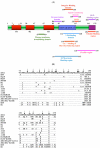Conformational Differences Unfold a Wide Range of Enterotoxigenic Abilities Exhibited by rNSP4 Peptides from Different Rotavirus Strains
- PMID: 22253650
- PMCID: PMC3256577
- DOI: 10.2174/1874357901105010124
Conformational Differences Unfold a Wide Range of Enterotoxigenic Abilities Exhibited by rNSP4 Peptides from Different Rotavirus Strains
Abstract
NSP4 has been recognized as the rotavirus-encoded enterotoxin. However, a few studies failed to support its diarrheagenic activity. As recombinant NSP4 (rNSP4) peptides of different lengths were used in the limited number of studies, a comparison of relative diarrheagenic potential of NSP4 from different strains could not be possible. To better understand the diarrheagenic potential of NSP4 from different strains, in this report we have evaluated the enterotoxigenic activity of the deletion mutant ΔN72 that lacks the N-terminal 72 residues and the biologically relevant ΔN112 peptide which when derived from SA11 rotavirus strain were previously shown to be highly diarrheagenic in newborn mice. Detailed comparative analysis of biochemical and biophysical properties and diarrheagenic activity of the recombinant ΔN72 peptides from seventeen different strains under identical conditions revealed wide differences among themselves in their resistance to trypsin cleavage, thioflavin T (ThT) binding, multimerization and conformation without any correlation with their diarrhea inducing abilities. These results support our previously proposed concept for the requirement of a unique conformation for optimal biological functions conferred by cooperation between the N- and C-terminal regions of the cytoplasmic tail.
Keywords: NSP4; Rotavirus diarrhea; diarrheal dose 50 (DD50); multimerization; nonstructural protein 4; thioflavin T; viral enterotoxin.; virulence.
Figures





Similar articles
-
The flexible C terminus of the rotavirus non-structural protein NSP4 is an important determinant of its biological properties.J Gen Virol. 2008 Jun;89(Pt 6):1485-1496. doi: 10.1099/vir.0.83617-0. J Gen Virol. 2008. PMID: 18474565
-
N- and C-terminal cooperation in rotavirus enterotoxin: novel mechanism of modulation of the properties of a multifunctional protein by a structurally and functionally overlapping conformational domain.J Virol. 2006 Jan;80(1):412-25. doi: 10.1128/JVI.80.1.412-425.2006. J Virol. 2006. PMID: 16352566 Free PMC article.
-
Structure of the extended diarrhea-inducing domain of rotavirus enterotoxigenic protein NSP4.Arch Virol. 2007;152(5):847-59. doi: 10.1007/s00705-006-0921-x. Epub 2007 Jan 31. Arch Virol. 2007. PMID: 17265103
-
Novel pentameric structure of the diarrhea-inducing region of the rotavirus enterotoxigenic protein NSP4.J Virol. 2011 Dec;85(23):12721-32. doi: 10.1128/JVI.00349-11. Epub 2011 Sep 14. J Virol. 2011. PMID: 21917949 Free PMC article.
-
Diarrhea induction by rotavirus NSP4 in the homologous mouse model system.Virology. 1999 Sep 30;262(2):398-407. doi: 10.1006/viro.1999.9912. Virology. 1999. PMID: 10502518
Cited by
-
Understanding the penetrance of intrinsic protein disorder in rotavirus proteome.Int J Biol Macromol. 2020 Feb 1;144:892-908. doi: 10.1016/j.ijbiomac.2019.09.166. Epub 2019 Nov 15. Int J Biol Macromol. 2020. PMID: 31739058 Free PMC article.
-
Structural plasticity of the coiled-coil domain of rotavirus NSP4.J Virol. 2014 Dec;88(23):13602-12. doi: 10.1128/JVI.02227-14. Epub 2014 Sep 17. J Virol. 2014. PMID: 25231315 Free PMC article.
References
-
- Estes MK. In: Fields Virology. 4th. Knipe DM, Howley PM, Griffin DE, Lamb RA, Martin MA, Roizman B, KK Straus SE, editors. Vol. 2. Philadelphia: Lippincott Williams and Wilkins; 2001. pp. 1747–85.
-
- Ball JM, Tian P, Zeng CQ-Y, Morris AP, Estes MK. Age-dependent diarrhea induced by a rotavirus nonstructural glycoprotein. Science. 1996;272 :101–4. - PubMed
-
- Deepa R, Rao CD, Suguna K. Structure of the extended diarrhea-inducing domain of rotavirus enterotoxigenic protein NSP4. Arch Virol. 2007;152:847–59. - PubMed
LinkOut - more resources
Full Text Sources
Research Materials
